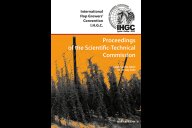Hopfen – Wissenschaftlich-Technische Kommission des Internationalen Hopfenbaubüros (IHB)
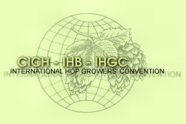
Wissenschaftlich-Technische Kommission des IHB
Unter der Dachorganisation des Internationalen Hopfenbaubüros (IHB) erfüllt die Wissenschaftlich-Technische Kommission (WTK) den Auftrag, Hopfenexperten aus aller Welt zum regelmäßigen Informations- und Gedankenaustausch zusammenzubringen.
Tagung der Wissenschaftlich-Technischen Kommission (WTK) des Internationalen Hopfenbaubüros (IHB) 2025 in Spalt
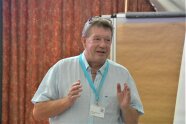 Zoombild vorhanden
Zoombild vorhanden
WTK-Chairman und Organisator Dr. Florian Weihrauch bei der Eröffnung der Tagung am 30. Juni 2025.
 Zoombild vorhanden
Zoombild vorhanden
76 Teilnehmer aus 15 Nationen verfolgten interessiert die 33 Vorträge.
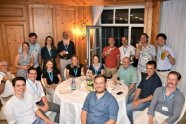 Zoombild vorhanden
Zoombild vorhanden
Impression gegen Ende des offiziellen Tagungsdinners. Im Hintergrund mit weißem Vollbart der lokale Organisator Dr. Frank Braun.
Meeting 2025 of the Scientific-Technical Commission (STC) of the International Hop Growers’ Convention (IHGC) in Spalt
 Zoombild vorhanden
Zoombild vorhanden
STC chairman and conference organizer Dr. Florian Weihrauch during the opening of the meeting on 30 June 2025
 Zoombild vorhanden
Zoombild vorhanden
Seventy-six attendees from 15 hop growing countries followed the 33 oral presentations with great interest.
 Zoombild vorhanden
Zoombild vorhanden
Impression towards the end of the official conference dinner. In the background, with a full white beard, is the local organizer, Dr Frank Braun.
Hopfenorden des IHB
Die Verleihung des Hopfenordens reicht bis in 14. Jahrhundert zurück. Johann der Furchtlose, Herzog von Burgund und König von Brabant, hat damals den Hopfenorden eingeführt, um verdiente Personen zu ehren, die sich für den Hopfen und dessen Entwicklung in besonderer Weise hervorgetan haben. Mehr
Dabei werden drei Stufen des Hopfenordens unterschieden – hier nach steigendem Ansehen gelistet:
- Ritter des Hopfenordens
- Offizier des Hopfenordens
- Kommandant des Hopfenordens
The award of the Order of the Hop dating back to the 14th century was initiated by John the Fearless, duke of Burgundy and king of Brabant, to honor persons for their outstanding achievements in hop production and its development.
There are three ranks of the Order of the Hop – listed here in rising reputation:
- Knight of the Order of the Hop
- Officier of the Order of the Hop
- Commander of the Order of the Hop
Sortenliste 2024 des Internationalen Hopfenbaubüros (IHB)
Diese offizielle Sortenliste des IHB ist nicht nur als Hilfsinstrument für das amtliche Zertifizierungsverfahren gedacht, sondern soll vor Allem jedes Jahr einen aktuellen Überblick zu dem immer unübersichtlicheren und zunehmend dynamischen Feld der internationalen Sortenvielfalt liefern und wird jedes Jahr zur Fachmesse BrauBeviale im November in Nürnberg veröffentlicht. Die aktuell vorliegende Version für das Anbaujahr 2024 wurde bei der Sitzung des IHB-Exekutivkomitees am 25. November 2024 in Nürnberg diskutiert und ratifiziert.
Die aktualisierte IHGC-Sortenliste für 2024 umfasst 331 Einträge (329 verschiedene Sorten), die im Jahr 2024 in einem der IHGC-Hopfenanbauländer zu wirtschaftlichen Zwecken angebaut wurden. Im Vergleich zur vorherigen Liste 2023 bedeutet dies einen Zuwachs von 19 Sorten.
Neu auf der Liste sind (in alphabetischer Reihenfolge): Anchovy (US), Elani™ (US), Erebus™ (US), Krush™ (US), Luminosa (US), Pink (US), Ruslan (UA), SAST-4 (CN), Superdelic™ (NZ), Tangier™ (US) und Zumo™ (US).
Darüber hinaus ist es uns gelungen, aktuelle Informationen über den Hopfenanbau in Russland zu erhalten. Die russische Hopfenproduktion war einige Jahre lang eine weitgehend unbekannte Größe. Mittlerweile hat die Russische Föderation damit begonnen, die nationale Hopfenproduktion wiederzubeleben, vor allem in den Republiken Tschuwaschien, ca. 400 km östlich von Moskau an der Wolga, und Altai an der südlichen Grenze Russlands, angrenzend an Kasachstan und die Mongolei. Im Jahr 2022 betrug die Anbaufläche in Russland 135 ha und hat seither leicht zugenommen. Daher haben wir die folgenden russischen Sorten neu in die Liste aufgenommen: Civilskiy, Druzhniy, Fakir, Favorit, Feodal, Flagman, Forward, Krilatskiy, Mikhailovskiy, Pharaon und Sumer. Dabei ist zu beachten, dass die Sorten, die mit „F“ oder „Ph“ beginnen, Sortencodes erhalten haben, die mit einem „W“ beginnen, was im Hinblick auf die korrekte Transkription vom Kyrillischen ins Lateinische Sinn ergibt.
Andererseits sind auch drei Verluste zu beklagen: Die Sorten Lomik (PL), Medusa (US) und Relax (DE) werden nicht mehr angebaut.
Als neues Feature der Liste haben wir jede Sorte, die in einem bestimmten Land auch unter ökologischen Bedingungen angebaut wird, zusätzlich mit einem zweiten grünen X (XX) versehen. Dies bedeutet einen Mehrwert der Liste, ohne ihre Struktur zu verändern. Derzeit werden 90 Hopfensorten (27,4 %) in einem oder mehreren Hopfenanbauländern auch unter ökologischem Regime angebaut.
Die nächste Aktualisierung der internationalen Sortenliste erfolgt im November 2025.
Für die Wissenschaftlich-Technische Kommission des IHB:
Dr. Florian Weihrauch
Chairman
The 2024 IHGC List of Hop Varieties, Update and modifications
The updated 2024 IHGC List of Hop Varieties comprises 331 entries (329 distinct cultivars) that have been cultivated with an economical purpose in one of the IHGC hop growing nations in 2024. Compared to the previous 2023 list, this means an increase of 19 cultivars.
New on the list are (alphabetically):
Anchovy (US), Elani™ (US), Erebus™ (US), Krush™ (US), Luminosa (US), Pink (US), Ruslan (UA), SAST-4 (CN), Superdelic™ (NZ), Tangier™ (US), and Zumo™ (US).
In addition, we were able to receive current information on hop cultivation in Russia, which had been under the radar for some years. The Russian Federation has begun to revitalize national hop production, chiefly in the Republics of Chuvashia (ca 400 km east of Moscow, on river Volga) and Altai (on the southern border of Russia, bordering Kazakhstan and Mongolia). The crop area of Russia was 135 ha in 2022, with a slight increase since.
Therefore, we have included the following Russian varieties as new to the list:
Civilskiy, Druzhniy, Fakir, Favorit, Feodal, Flagman, Forward, Krilatskiy, Mikhailovskiy, Pharaon, and Sumer. Note that the varieties beginning with ‘F’ or ‘Ph’ received variety codes beginning with a ‘W’, which makes sense regarding the correct transcription from Cyrillic to Latin.
On the other hand, we must mourn three losses: The varieties Lomik (PL), Medusa (US), and Relax (DE) are no longer cultivated.
As a new feature of the list, we have now additionally indicated by a second green X (XX) when a cultivar is also grown in a certain nation under an organic regime. This is additional value of the list without changing its structure. Currently, 90 cultivars of the list (27.4%) are also grown organically in one or several hop growing nations.
For the Scientific-Technical Commission, IHGC:
Dr Florian Weihrauch
Chairman
Rückblick: Tagungen der WTK
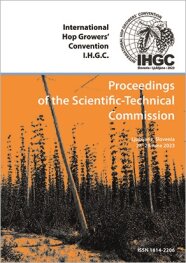
IHGC-Frontcover 2023
In neun Sessions wurden 36 Vorträge gehalten, die die gesamte Bandbreite der Hopfenforschung abdecken. Die Themenblöcke reichten von der Hopfenzüchtung über Phytopathologie und Viroide, Hopfenanbau, Entomologie und Hopfenaroma bis hin zu Fragen der Hopfenqualität. Zudem wurden noch 20 Poster inklusive einer kurzen mündlichen Vorstellung präsentiert. Alle Tagungsbeiträge sind in dem Proceedings-Band auf 151 Seiten in schriftlicher Form dokumentiert, den jeder Teilnehmer in gedruckter Form erhalten hat. Zudem sind die Proceedings in elektronischer Form online abrufbar. Eine halbtägige Exkursion ins Hopfenanbaugebiet rund um Žalec rundete die Tagung trotz des Regens an diesem Tag erfolgreich ab.
Meeting of the Scientific-Technical Commission, I.H.G.C., in Ljubljana, Slovenia 2023
Slovenia can look back on a long and eventful history of hop growing and is one of the six largest hop-growing countries in the world. Our local hosts were our IHB colleagues from the Slovenian Institute for Hop Research and Brewing in Žalec, with Dr Andreja Čerenak as head of the organising committee. We are very grateful to our Slovenian friends for providing us with this great opportunity and a wonderful destination for our meeting. Anyone who has not yet seen Ljubljana should visit this charming European capital.

IHGC-Frontcover 2023
 Zoombild vorhanden
Zoombild vorhanden
Knapp 60 Hopfenwissenschaftler aus zehn Nationen nahmen 2022 an der Tagung der WTK in Lugo im spanischen Galizien teil.
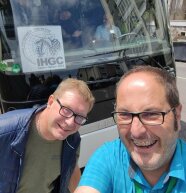 Zoombild vorhanden
Zoombild vorhanden
Die Organisatoren Florian Weihrauch (links) und Javier Cancela vor der Abfahrt zur Exkursion.
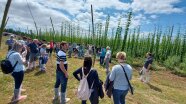 Zoombild vorhanden
Zoombild vorhanden
Bei Mabegondo gewannen die Exkursionsteilnehmer tiefere Einblicke in den galizischen Hopfenbau.
Doch eine gute Tagung besteht bekanntermaßen aus viel mehr als nur einem anspruchsvollen wissenschaftlichen Programm. Dementsprechend wurde schon der erste Tag des Meetings von einer Führung durch Lugos historisches Zentrum abgeschlossen, die den Kongressteilnehmern interessante Einblicke in die Geschichte der traditionslastigen Stadt gewährte. Die Führung endete schließlich in der Altstadt mit ihrem pittoresken Bermuda-Dreieck des Kneipenviertels, wo in den bares speziell georderte tapas und Craft-Biere auf die Gruppe warteten.
 Zoombild vorhanden
Zoombild vorhanden
Der Besuch des Museums "Mundo Estrella Galicia" (MEGA) der gleichnamigen galizischen Großbrauerei in der Hafenstadt A Coruña war ein Highlight des Exkursionstages.
Meeting of the Scientific-Technical Commission, I.H.G.C. (STC) 2022 in Lugo, Galicia, Spain
 Zoombild vorhanden
Zoombild vorhanden
Nearly 60 hop scientists from ten nations participated in the 2022 STC meeting in Lugo.
 Zoombild vorhanden
Zoombild vorhanden
Florian Weihrauch (left) and Javier Cancela, organisers of the STC meeting, just before the departure to the excursion.
 Zoombild vorhanden
Zoombild vorhanden
Near Mabegondo the participants of the excursion were informed on-site about hop growing in Galicia.
However, common knowledge tells that a good conference consists of much more than just a demanding scientific programme. Accordingly, the very first day of the meeting was concluded by a guided tour through Lugo's historical centre, which gave the congress participants interesting insights into the history of the city. The tour finally ended in the old town with its picturesque Bermuda Triangle of the pub district, where specially ordered tapas and craft beers awaited the group in the local bares.
 Zoombild vorhanden
Zoombild vorhanden
A visit to the museum "Mundo Estrella Galicia" (MEGA), built by the major Galician brewery of the same name in the seaport A Coruña, was highlight of the excursion.
Another social highlight was the official conference dinner on the last evening. As a special surprise, hop orders were again awarded to two merited scientists at the request of the STC: French colleagues Michèle Dauger and Bernadette Laugel-Niess, who had perfectly organised the last meeting of 2019 in Alsace for the STC, were each awarded the Order of the Hop with the rank of a Chevalier.
The next WTK meeting is planned after only a one-year break to return to the rotation of odd years and will take place from 25th to 29th June 2023 in the Slovenian capital Ljubljana.
 Zoombild vorhanden
Zoombild vorhanden
Über 60 Hopfenwissenschaftler aus elf Nationen nahmen 2019 an der Tagung der WTK im Elsass teil.
 Zoombild vorhanden
Zoombild vorhanden
Gruppenbild aller Teilnehmer der Wissenschaftlich-Technischen Kommission 2019
Alle Tagungsbeiträge sind zumindest als Zusammenfassung schriftlich dokumentiert und können in den Proceedings auf 122 Seiten nachgelesen werden. Jeder Teilnehmer hat ein gedrucktes Heft erhalten, und zudem sind die Proceedings hier digital online abrufbar. Eine halbtägige Exkursion ins Hopfenanbaugebiet Elsass mit Besichtigung der Landwirtschaftsschule in Obernai – hier werden auf 30 ha Biohopfen kultiviert – sowie einem Besuch der "Brasserie Perle" in Straßburg, gefolgt von anschließender geselliger Runde bei Flammkuchen und regionalen Bieren und Weinen, bot bunte Einblicke in die elsässische Kultur. Ein weiteres soziales Highlight war das offizielle Tagungsdinner am letzten Abend, das als bei perfektem Wetter als wunderbares Barbecue unter freiem Himmel angesetzt wurde. Als besondere Überraschung wurden zu diesem Anlass auf Antrag der WTK Hopfenorden an zwei verdiente Wissenschaftler verliehen, an Dr Elisabeth Seigner im Rang eines Offiziers und an Dr. Karel Krofta im Rang eines Ritters (siehe separaten Bericht).
 Zoombild vorhanden
Zoombild vorhanden
Nestor der intern. Brauwissenschaften, Prof. Ludwig Narziß, WTK-Vorsitzender Florian Weihrauch
Programmüberblick
Postergalerie
- Eggplant (Solanum melongena) as indicator plant for Verticillium
 3,0 MB
3,0 MB
- Hop harvest residues: Options for effective usage in terms of nitrogen efficiency
 2,8 MB
2,8 MB
- Detached Leaf Assay to Test for Downy Mildew Tolerance in Hops
 1,4 MB
1,4 MB
- Real-time PCR based Diagnostics and Meristem Culture – Essential Tools for Healthy Hops
 687 KB
687 KB
- Non-destructive assessment of plant nitrogen status in hops using leaf chlorophyll measurements
 833 KB
833 KB
 Zoombild vorhanden
Zoombild vorhanden
Hop scientists from all over the world attended the 2019 meeting of the Scientific-Technical Commission in Alsace, France.
 Zoombild vorhanden
Zoombild vorhanden
Group picture of all attendees of the Scientific-Technical Commission 2019
All papers from the conference are at least documented as a summary in the STC Proceedings on 122 pages, which each attendee has received in print and which also are available online in digital form here. A half-day excursion to the Alsace hop growing area, including the Agricultural School in Obernai with 30 ha of organic hops and a visit of the ‘Brasserie Perle’ in Strasbourg, followed by a typical Alsacian dinner with tarte flambée and great local beers & wines, rounded off the conference.
 Zoombild vorhanden
Zoombild vorhanden
Legend of brewing science, Prof. Ludwig Narziß, STC-C. Florian Weihrauch
Programme outline
Poster Gallery
- Eggplant (Solanum melongena) as indicator plant for Verticillium
 3,0 MB
3,0 MB
- Hop harvest residues: Options for effective usage in terms of nitrogen efficiency
 2,8 MB
2,8 MB
- Detached Leaf Assay to Test for Downy Mildew Tolerance in Hops
 1,4 MB
1,4 MB
- Real-time PCR based Diagnostics and Meristem Culture – Essential Tools for Healthy Hops
 687 KB
687 KB
- Non-destructive assessment of plant nitrogen status in hops using leaf chlorophyll measurements
 833 KB
833 KB
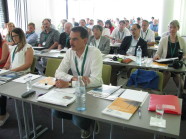 Zoombild vorhanden
Zoombild vorhanden
Hopfenwissenschaftler aus aller Welt nahmen an der Tagung der Wissenschaftlich-Technischen Kommission teil.
Foto: Florian Weihrauch
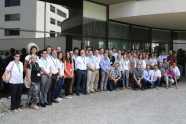 Zoombild vorhanden
Zoombild vorhanden
"Familienfoto" aller Teilnehmer der Wissenschaftlich-Technischen Kommission 2017.
Foto: Lydia Junkersfeld, Brauwelt
 Zoombild vorhanden
Zoombild vorhanden
Dr. Florian Weihrauch übernahm am 26. Juni 2017 den Vorsitz der WTK von Dr. Elisabeth Seigner.
Foto: Lydia Junkersfeld, Brauwelt
Detaillierter Überblick des Programmablaufes:
 Zoombild vorhanden
Zoombild vorhanden
Hop scientists from all over the world attended the 2017 meeting of the Scientific-Technical Commission.
Photo: Florian Weihrauch
 Zoombild vorhanden
Zoombild vorhanden
"Family picture" of all attendees of the Scientific-Technical Commission 2017.
Photo: Lydia Junkersfeld, Brauwelt
 Zoombild vorhanden
Zoombild vorhanden
Dr. Florian Weihrauch took over the chair of the STC from Dr. Elisabeth Seigner.
Photo: Lydia Junkersfeld, Brauwelt
Programme outline:
Proceedings of the STC meeting in St. Stefan am Walde, Austria, June 2017
Conference agenda:

Vom 4. bis 9. Juni 2013 war die Ukraine zum allerersten Mal Gastland für die alle 2 Jahre stattfindende Tagung der Wissenschaftlichen Kommission (WK). Auf Einladung der Vorsitzenden der WK Dr. Elisabeth Seigner, Hopfenforschungszentrum Hüll der Bayerischen Landesanstalt für Landwirtschaft, und von Prof. Dr. Maksym Melnychuk, Vize-Rektor der Nationaluniversität für Bio- und Umweltwissenschaften (NULES), kamen 49 Hopfenwissenschaftler und Experten der Hopfen- und Brauindustrie aus 12 Hopfenbauländern nach Kiew. In 22 Vorträgen und 13 Postern wurde die gesamte Bandbreite der Hopfenforschung vorgestellt. Darüber hinaus wurden in "Workgroups" aktuelle Forschungsthemen bearbeitet und vertieft. Mehr
Mit der Tagung der Wissenschaftlichen Kommission (WK) in Polen wurde die Tradition fortgeführt, alle zwei Jahre die Hopfen-Wissenschaftler aus aller Welt im Namen des Internationalen Hopfenbaubüros zum Informationsaustausch zusammenzuführen. Auf Einladung von Frau Prof. Dr. Ewa Solarska, University of Life Sciences in Lublin, als Gastgeberin, und Dr. Elisabeth Seigner, Hopfenforschungszentrum Hüll der Bayerischen Landesanstalt für Landwirtschaft, als Vorsitzende der WK, kamen 52 Teilnehmer aus 13 Hopfenbaunationen zu dieser Tagung.
Postergalerie – Poster gallery
- Trends In Hop Breeding – new Aroma and Bitter Qualities at the Hop Research Center Huell
 730 KB
730 KB
- Vital – New Czech Hop Variety[/lang]
 362 KB
362 KB
- Variability Of Wild Hops
 487 KB
487 KB
- Breeding for Resistance to Hop Powdery Mildew in Poland
 869 KB
869 KB
- New Biotechnological Approaches of Growing Hop in the Ukraine
 11,4 MB
11,4 MB
- Generation of triploids of hop (Humulus lupulus L.)
 255 KB
255 KB
- Ploidy and sex expression in monoecious hop plants
 906 KB
906 KB
- Complementation analysisof hop transcription factors using Arabidopsis thalania genes in transient system and in transgenotes
 1,5 MB
1,5 MB
- Hop stunt viroid (HSVd) disease causes alteriation of expression of hop transcription factors from MYB, bHLH and WRKY families
 509 KB
509 KB
- Study of the Production of Secundary Metabolites in Shoot and Callus Cultures and Field Grown Plants of Hop
 467 KB
467 KB
- Effect of Genotype and Season on Antioxidant Activities of Hop Extracts from Leaves
 591 KB
591 KB
- Bioactive Compounds in Hop Cultivars Growing in Poland
 1,5 MB
1,5 MB
- Influence of Isomerisation on the Composition of Hop Resins and Essential Oils
 2,5 MB
2,5 MB
- Hop Pesticide Screening Programme by V.F. Humulus
 3,0 MB
3,0 MB
- Hop Protection Against Alfalfa Snout Beetle With the Help of Meteorological Data in Bohemian and Moravian Hop Gardens
 386 KB
386 KB
- Species of Flea Beetles Attacking Hop Plants in Czech Hop Gardens
 390 KB
390 KB
- Studies of Verticillium Wilts in Hops
 561 KB
561 KB
- Development of Low Trellis in Czech Republic
 367 KB
367 KB
- Device for automated attachement of the supporting wires in hop-growing
 844 KB
844 KB
- Sensor controlled single plant treatment in the pesticide application
 355 KB
355 KB
- Pesticide reduction through sensor implementation
 550 KB
550 KB
Eindrücke von der Tagung in Lublin
Dieses Mal war Spanien das Gastland und die Einladung kam von der S.A. Española de Fomento del Lúpulo, die als private, von der spanischen Brauwirtschaft und den spanischen Pflanzern getragene Organisation, den Hopfenanbau und -handel in Spanien fördert.
Postergalerie - Poster gallery
- Potentially dangerous fusaroid microorganisms associated with rot of hop plants in field culture
 7,6 MB
7,6 MB
- Drying hops with thermal solar power: optimization of the energetic efficiency of the process to obtain a hop quality product
 1,2 MB
1,2 MB
- Evaluation of health state of hops in Trschitz growing region
 2,7 MB
2,7 MB
- Gene expression and identification of full-length cDNA sequences of hop (humulus lupulus l.) candidate genes of the prenylflavonoid pathway
 544 KB
544 KB
- Geographical origin of hops – determination by Isotope Ratio Mass Spectroscopy (IRMS)
 444 KB
444 KB
- Herkules – the new Hüll high alpha cultivar
 298 KB
298 KB
- Hop breeding on high contents of desmethylxanthohumol
 3,0 MB
3,0 MB
- The right time to harvest optimal yield and quality
 518 KB
518 KB
- Identification of czech hop varieties by essential oil analysis
 10,0 MB
10,0 MB
- Influence of Vegetation Period on Antioxidant and Biocide Activity of Extracts from Hop Leaves
 14,4 MB
14,4 MB
- Methods of in vitro storage of hops
 1,6 MB
1,6 MB
- Polyphenol and Flavonoid Contents of Hop Callus and Cell Suspension Cultures
 1,2 MB
1,2 MB
- Prognosis of Damson-Hop Aphid within Hop Protection Management in Czech Republic
 2,8 MB
2,8 MB
- Prognosis of Downy Mildew within Hop Protection Management in Czech Republic
 3,2 MB
3,2 MB
- Recovering Hop Cultivation in Galicia (NW Spain)
 181 KB
181 KB
- Relationship between Xanthohumol, Polyphenols and Flavonoids Content in Hop Leaves with Regard to Vegetation Period
 8,8 MB
8,8 MB
- Utilisation of Irrigation Systems in Hop Production
 3,3 MB
3,3 MB
Postergalerie – Poster gallery
- Agrobacterium-Mediated Transformation of Hop
 385 KB
385 KB
- The biosynthesis of the bitter acids in hops
 93 KB
93 KB
- The Compendium of Hop Diseases, Arthropod Pests and Other Disorders
 613 KB
613 KB
- Cryopreservation of Hop Tips
 772 KB
772 KB
- Influence of weather conditions and irrigation on yield and quality of hop
 643 KB
643 KB
- Genetic variability of wild hops in Caucasus region
 549 KB
549 KB
- Genome Analysis – an Important Tool to Support Classical Hop Breeding
 601 KB
601 KB
- Molecular Variability within the coat protein gene of Hop mosaic and Hop Latent carlaviruses
 648 KB
648 KB
- Hop wire-works in Czech republic
 526 KB
526 KB
- Nematodes associated with hop production in Tasmania, Australia
 322 KB
322 KB
- Contents of pesticide residues in hop
 609 KB
609 KB
- Low Molecular Polyphenols in Beer Influenced by Different Hop Varities
 714 KB
714 KB
- Optimisation of the Real Time RT-PCR Protocol for the Analysis of Gene Expression in Hop Tissues
 254 KB
254 KB
- Proteomic analysis of the fungus Verticillium albo-atrum
 1,2 MB
1,2 MB
- Wild Hops from the Northern Parts of Caucasus
 475 KB
475 KB
- Variability of wild hops in Czech Republic
 546 KB
546 KB
- Evaluation of some wild hops from Europe
 143 KB
143 KB
- Wild Hops – New Sources for Resistance to Powdery Mildew
 516 KB
516 KB
Postergalerie - Poster gallery
- Callus-Derived Hop Plants Show Correlation Between Epigenetic Instability And Time In Culture
 640 KB
640 KB
- Transfer of a resistance gene into hops
 1,3 MB
1,3 MB
- Identification of gibberellins and involvement in hop flowering
 1,6 MB
1,6 MB
- Production Of Xanthohumol Enriched Hop Extracts Using Carbon Dioxide As Solvent At Pressures Up To 1000 Bars
 168 KB
168 KB
Postergalerie - Poster gallery
- The Antibacterial Activity of Hop Compounds
 40 KB
40 KB
- The Spatial Pattern of Hop Powdery Mildew in Pacific Northwestern USA
 193 KB
193 KB
- Evaluation of Somaclonal Variation in Hops by AFLPs
 112 KB
112 KB
- AFLP Fingerprinting of Fungi of the Genes Verticillium
 1,3 MB
1,3 MB
- Assessment of somaclonal variability in hop in vitro culture by molecular methods
 140 KB
140 KB












